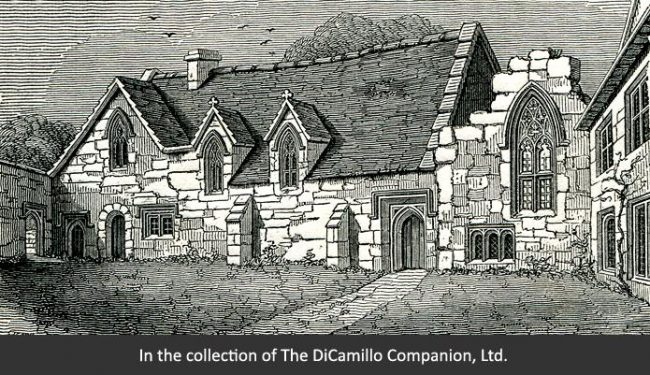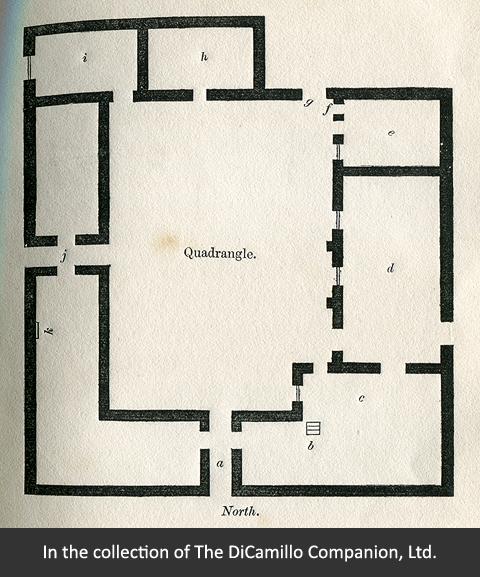
The west side of the quadrangle of the house from the 1850 book "An Historical and Descriptive Account of Cumnor Place, Berkshire."

A plan of the ground floor of the house from the 1850 book "An Historical and Descriptive Account of Cumnor Place, Berkshire."

“Blackmore Vale from Shaftesbury,” a scene from Thomas Hardy’s "Jude the Obscure." A 1906 color print from a painting by Walter Tyndale.
House & Family History: Located on the west side of the churchyard, Cumnor Place was a medieval stone house with a central courtyard (quadrangle) built by the Ecclesiastics of Abington during the reign of Edward III. At one time it was believed to have been built as a lazaretto, or place of removal, for the monks of Abington to escape epidemics in the village, but Cumnor Place is now thought to have been designed as the country house and refectory for the abbot of Abington. The abbot also served as the lord of the hundred, and it was at Cumnor that the hundred and manor courts were held. After the Dissolution of the Monasteries, Cumnor Place passed into the ownership of George Owen, physician to Henry VIII, from whom Owen purchased it on October 8, 1546 for £309 12s 9d, together with the lands of Rowley Abbey in Oxfordshire. In 1561, after the death of his father, William Owen sold the Cumnor Estate to Anthony Forster, who had been tenanting the house. Forster made extensive alterations in the Tudor style, and it was during his ownership that Cumnor Place was at its most magnificent. The house is famous to us today as the home of Amy Robsart, wife of Lord Robert Dudley, later the Earl of Leicester, a favorite of Queen Elizabeth I. The mysterious death of Lady Dudley on September 8, 1560 (she was found dead at the bottom of the stairs, possibly murdered) caused seismic vibrations throughout Elizabethan England. Queen Elizabeth I was supposedly in love with Robert Dudley and the suspicion has always been that Amy was murdered to clear the way for Dudley to marry Elizabeth. Nothing on that account has ever been proved, but the taint remained and the queen never married. Ironically, when Anthony Forster died in 1572, he left Cumnor Place to Robert Dudley. Beginning at the end of the 16th century, the house remained vacant for over one hundred years, during which time it became ruinous. Certainly one of the reasons nobody wanted to live here was the reputation it had for being haunted by Amy Dudley's ghost (it was during this time that it began to be called Dudley Castle). Her ghost supposedly appeared in the form of a beautiful, well-dressed woman who was seen at the bottom of the stone staircase in the northwest section of the house where her body was found. The entire village of Cumnor came to fear the house and believed that, because of Amy's unexorcised ghost, the village was cursed. The panic reached such a fever pitch that the villagers supposedly engaged nine parsons from Oxford to exorcise Amy's ghost. The religious men laid the ghost in a pond, at which spot it was said the water ever after refused to freeze. Eventually Cumnor Place was fixed up and divided into tenements for laborers. Finally, in 1810, during the ownership of the earls of Abingdon, the house was demolished. Montague Bertie, 5th Earl of Abingdon, ordered its destruction and used the house's stone for the rebuilding of All Saints Church in nearby Wytham. The village of Cumnor was the inspiration for the fictional Lumsdon in Thomas Hardy's 1895 novel "Jude the Obscure."
Title: Historical and Descriptive Account of Cumnor Place, Berks, With Biographical Notices of The Lady Amy Dudley and of Anthony Forster, Esq., An
Author: Bartlett, Alfred Durling
Year Published: 1850
Reference: pgs. 2-11
Publisher: Oxford and London: John Henry Parker
ISBN: NA
Book Type: Hardback
House Listed: Demolished
Park Listed: Not Listed
Past Seat / Home of: Oliver Wellesborne, 16th century (probably let from the Crown). George Owen, 16th century. Anthony Forster, 16th century. Amy Robsart, wife of Lord Robert Dudley, Earl of Leicester, 16th century. Montague Bertie, 5th Earl of Abingdon, 19th century.
Current Ownership Type: Demolished
Primary Current Ownership Use: Demolished
House Open to Public: No
Historic Houses Member: No